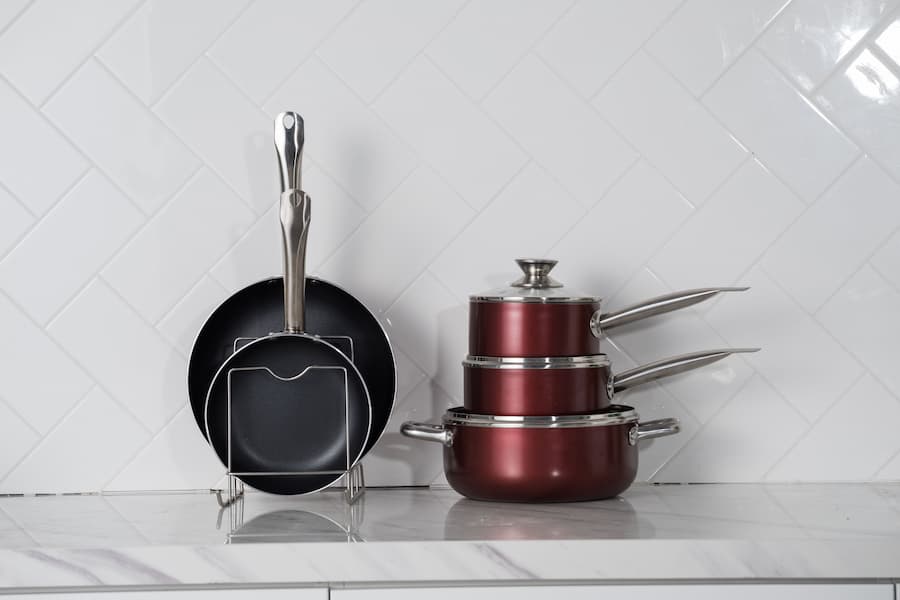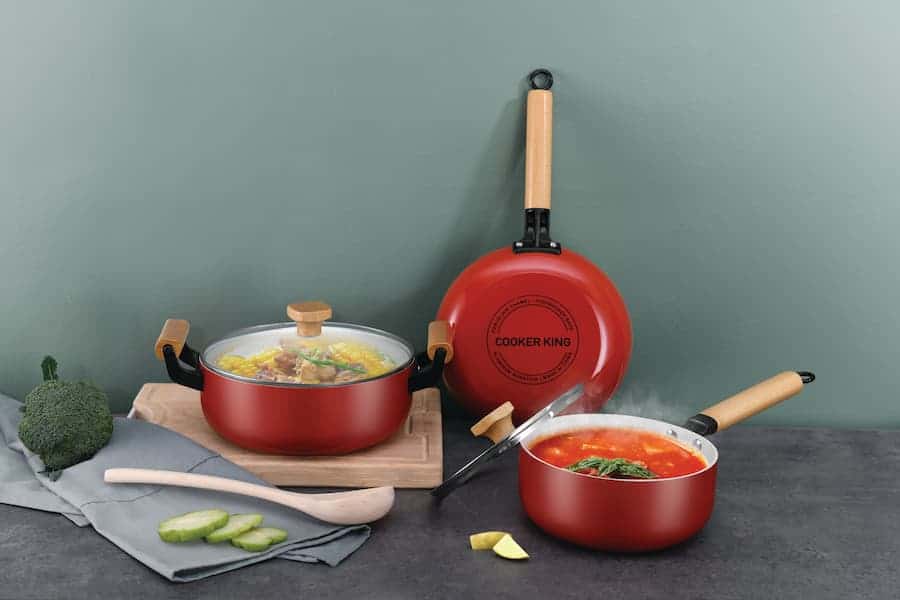As an Amazon Associate we earn from qualifying purchases.
Stainless steel cookware has been around for what seems like forever. Then about 60 years ago, cheap nonstick cookware was introduced. The newer variety of pots and pans were seen to be easier to use and maintain. So, stainless steel vs nonstick, which is better?
Quick Navigation
Stainless Steel vs Nonstick
Nonstick pans make cooking delicate foods such as pancakes a breeze. They also eliminate the frustration of having to chisel burnt food from stainless steel pans.

Even though their appeal is undeniable, traditional stainless steel pans are still the go-to cookware for culinary masters and professional chefs.
Cooking with stainless steel vs. nonstick is an age-old debate with strong arguments being raised in favor or disservice of both materials.
What I can tell you is that each of these options plays a very distinct function in the kitchen. Then again, both materials have their pros and cons. In this post, I will share with you everything you need to know about nonstick and stainless steel cookware.
Stainless Steel Cookware
Modern manufacturers don’t make stainless steel cookware purely out of steel. Bear in mind that this material is a bad conductor of heat, and some enhancements ensure it can distribute heat better for superior food preparation results and ease of use.
That said, modern stainless steel cookware may have an aluminum or copper base. Some models also feature these good heat conductors pressed between two layers of stainless steel.
With or without these enhancements, professional chefs have good reason to feel that cooking with stainless steel is better. What sways their opinion in this direction?
The answer is simple. Compared to nonstick and other favorite cookware sets materials, stainless steel is more durable. This material can withstand higher temperatures without a problem, and even it is oven-friendly.
Thanks to the versatility of stainless steel, chefs can use it for cooking numerous dishes. Unfortunately, it is necessary to have a higher level of culinary mastery and maturity to use and also maintain this type of cookware effectively. Even master chefs can agree that stainless steel tends to be less forgiving.
In this case, you cannot take chances when deciding the ideal amount of lard, butter, or oil to use. Additionally, you have to preheat your pans to the right temperature and also ensure the correct temperature is maintained throughout the cooking process.
If you fail to adhere to certain dos and don’ts, there is a good likelihood that the outcome of your recipes will be disastrous.
On the other hand, knowing how to cook with stainless steel will enhance your chances of reaping the full perks of what this type of cookware has to offer.
Stainless Steel Cookware Pros
Longevity
The durability of stainless steel is unmatched. Because the material is both rust and stain-resistant, it can remain in excellent shape for ages.
Preserves the Authentic Flavors of Your Ingredients
A good number of cookware materials, including aluminum, can leach into food. Typically, the risk of leaching is greater when using highly acidic ingredients.
Fortunately, stainless steel cookware never leaks into food. This means the original flavors of your ingredients remain intact.
Environmentally Friendly
Stainless steel cookware can remain in pristine condition for years on end if it is properly maintained. If for some reason, your pots are damaged, they can be recycled to create other things.
Not Highly Porous
Stainless steel is indeed porous, and that is why it needs to be seasoned from time to time. However, it is not highly porous, so its pores cannot be felt or seen.
This is a characteristic that makes the material less likely to leak, crack, or dent.

Stainless Steel Cookware Cons
Culinary Mastery Is Crucial
Most people find out they don’t know how to cook with stainless steel after a feeble attempt to prepare something. For your cookware to produce professional-grade recipes, there are specific procedures you must follow.
For instance, you must season your pan, preheat it to just the right temperature, oil it, and know precisely when to flip your food. There is no room for mistakes, and even a minor blunder can turn your food into a mess.
Intricate Maintenance Procedure
Keeping your stainless steel cookware in top shape is not a job for the faint-hearted. After preparing a meal, you need to wipe off the oil residue using a paper towel and deglaze your pan before hand-cleaning it with hot spay water. Note that it is best to avoid using a dishwasher.
Nonstick Cookware
Nearly everyone’s kitchen will have at least one nonstick cookware. Pans with a nonstick coating are perfect for cooking delicate food such as eggs and fish.
Additionally, the cookware promotes healthy living because you can prevent food from sticking, even if you plan on not using too much butter, oil, or lard.
A good number of people are now opting to limit or even eliminate fat consumption. In this case, nonstick cookware is of great help.
On the downside, if your cookware was made before the early 2000s the coating can chip into your food or vaporize into the air and cause health concerns.
While the EPA and FDA claim that this substance can impact human health, other health organizations claim that it can cause cancer.
Even so, some people choose to learn the intricate curve of cooking with stainless steel simply because it is perceived to be a healthier option.
Nonstick Cookware Pros
Can Promote Healthy Eating Lifestyles
What is a known fact is that nonstick cookware allows people to use little or no fat when preparing food. This is seen to be healthy and instrumental in minimizing the risk of lifestyle diseases such as obesity.
Easy Maintenance
Compared to all other cookware materials, nonstick is the easiest to maintain. Just wash your pots with soapy water and avoid using abrasive cleaners that can damage the nonstick surface.
Easy to Use
You don’t need special culinary skills to cook using nonstick cookware. The coating naturally resists the sticking of food.
This makes it remarkably easy to make perfect meals, even when dealing with delicate dishes like fish, eggs, and pancakes.
Nonstick Cookware Cons
Coatings Like Teflon Can Pose Health Concerns
It is best to prevent the nonstick coating from chipping into your food. Never place empty pans on high heat and do not use metal utensils.
Not Ideal for High-Temperature Recipes
While stainless steel is a workhorse that can help you prepare all sorts of meals, nonstick cookware is only ideal for cooking low and moderate-heat recipes. This means it is not suitable for procedures such as searing meat.
Final Words
I hope I have settled the cooking with stainless steel vs nonstick debate. From where I stand, both types of cookware are great, and they serve a very distinct purpose in the modern kitchen. It is crucial to have them as part of your kitchen utility collection.
When preparing a specific meal, whether to use stainless steel or nonstick will depend highly on your needs. As long as you can effectively use both types of cookware, then the final decision should be based on your personal preferences.
